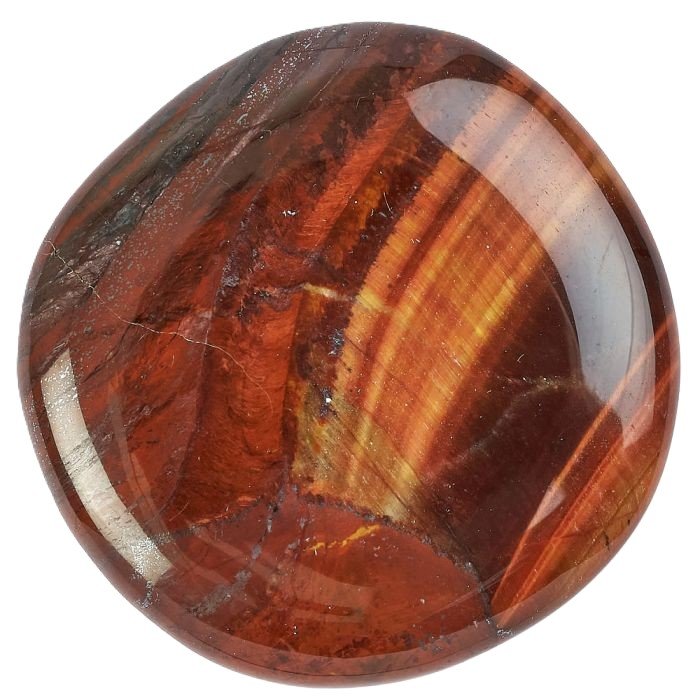
Red tigers Eye, also known as Dragon’s Eye or Ox’s Eye, owes its name to its striking resemblance to the mesmerising, gleaming eye of a tiger. This gemstone derives its reddish hue from heat treatments or natural oxidation of the golden-brown Tiger’s Eye. The term “Tiger’s Eye” originates from the silky lustre and chatoyant effect (optical reflectance) that mimics the dynamic appearance of a tiger’s gaze.
Composition, Physical Characteristics, and Varieties
Red Tiger’s Eye is a quartz variety belonging to the chalcedony family. Its fibrous structure consists of silicon dioxide with inclusions of crocidolite, an asbestos mineral replaced by quartz during its formation. The stone showcases a vibrant reddish-brown colour that enhances its chatoyancy—a shimmering band of light across its surface. This gemstone is a variant of the more commonly known golden-brown Tiger’s Eye and can develop its reddish tone naturally or through gentle heating. Varieties of Tiger’s Eye include Blue Tiger’s Eye (Hawk’s Eye) and Gold Tiger’s Eye, each distinguished by its colour and chatoyant quality.
Geographical Locations
Red Tiger’s Eye is primarily sourced from regions rich in quartz deposits. Significant mining locations include South Africa, which is the leading supplier, particularly for high-quality Tiger’s Eye; Western Australia, known for diverse quartz varieties; Namibia, renowned for its naturally occurring reddish hues; and India and Brazil, which also contribute to global production.
Archaeological and Historical Significance
Tiger’s Eye has fascinated civilizations for centuries. Roman soldiers carried it into battle, believing its protective energies would shield them from harm. In ancient Egypt, it was revered as a stone of divine vision, symbolising the eyes of deities such as Ra. While specific archaeological finds of Red Tiger’s Eye are rare due to its modern popularity, its parent stone, Tiger’s Eye, has consistently served as a talismanic charm throughout history.
Interesting Facts
The chatoyancy of Tiger’s Eye, including the red variety, results from parallel fibres reflecting light. Natural Red Tiger’s Eye is rarer than its golden counterpart and is often enhanced through heat treatment.
Folklore, Superstition, Legends, and Tales
Red Tiger’s Eye is steeped in lore and tradition. Ancient cultures associated the gemstone with vitality, strength, and courage. Some legends claimed it could ward off the evil eye and repel malevolent energies. In folklore, it was believed to ignite passion and balance emotional energies, making it a popular love token.
Mystical Healing Properties
Mystics attribute Red Tiger’s Eye with various metaphysical benefits. For physical healing, it is believed to boost metabolism, aid circulation, and support reproductive health. It is thought to promote emotional well-being by grounding, fostering resilience, and encouraging self-confidence. Spiritually, it is said to enhance focus, ambition, and the courage to overcome challenges.
Links with Astrology and the Zodiac
Red Tiger’s Eye resonates with the fire energy of zodiac signs like Leo and Scorpio. Its fiery hue and dynamic energy are thought to align with these passionate signs, enhancing their innate strengths and tempering their weaknesses. It is also considered a secondary stone for Capricorn, fostering perseverance and focus.
The Chakra System
This stone is closely tied to the lower chakras, particularly the Root Chakra, which provides grounding and stability; the Sacral Chakra, which ignites creative and sexual energies; and the Solar Plexus Chakra, which enhances confidence and personal power.
Birthstone and Wedding Anniversary Use
Although not a traditional birthstone, Red Tiger’s Eye is often adopted by individuals drawn to its vibrant energy. It is a thoughtful gift for the ninth wedding anniversary, symbolising resilience, strength, and a fiery passion.

Red tigers eye
Red Tiger’s Eye energises ambition, focus, and confidence. A dynamic stone for motivation, protection, and igniting personal power with steady drive.
